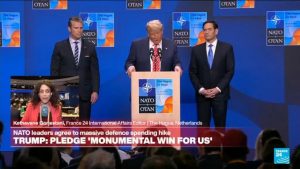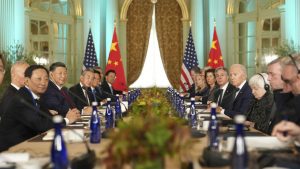
So the ‘24 hour’ summit parade – or should I say the Trump performance spectacle – continues. We saw his 24 hour star performance at the G7 Summit at Kananaskis – kept in line by Canada’s new prime minister Mark Carney; and now we played the audience to the 24 hour NATO summit choreographed by NATO Secretary-General Mark Rutte.
And now to his ‘star performance’ in the Hague at the NATO Summit. The event as we found out was finely tuned by the Secretary-General Mark Rutte including ending it after just 1 day to avoid, I presume, having Trump loudly leave the gathering early. Now in no way do I want to be dismissive of Rutte’s really excellent framing for the meeting. The marshalling of support was clearly described by our friends at the NYTimes:
“Mr. Rutte is skilled at handling Mr. Trump and has no embarrassment about flattering him. In an unusually unctuous message that Mr. Trump released on Tuesday, Mr. Rutte praised him for making Europe “pay in a BIG way” on increased military spending and for his “decisive action in Iran, that was truly extraordinary, and something no one else dared to do.””
“To try to ensure a smooth summit, Mr. Rutte said: “Donald, you have driven us to a really, really important moment for America and Europe, and the world,” getting allies to commit to spending 5 percent of their gross domestic product on defense. “You will achieve something NO American president in decades could get done,” Mr. Rutte added. NATO officials confirmed that the message, which Mr. Trump posted on social media, was authentic.”
The self congratulation was all about the commitment to raise defense spending demanded by Trump. And to be fair, objectively Trump’s insistence on greater defense spending efforts by NATO members was long overdue, especially in the light of continuing Russian actions against Ukraine and worries by Eastern European countries close to Russia. But even the agreement to move to 5 percent of GDP had a ‘sleight of hand’ at play as pointed to by the The Economist:
“The solution was two-fold. One trick was to stretch the timeline for meeting the target. Many states had pushed for 2032, with steady annual increases to get there. Others, though, under greater fiscal pressure—and not just Spain—pushed for 2035. In the end, regrettably, the laggards won, though allies are supposed to submit annual plans showing a “credible, incremental path” to the target, and will be subject to a bigger review in 2029.”
“The problem is that Russia is rebuilding its armed forces faster than previously thought. It had been assumed that it would take Russia seven years after any ceasefire in Ukraine to reconstitute its forces to the level needed for a confrontation with NATO. “The general assessment now should be five years,” one senior NATO official told The Economist. “Let’s not kid ourselves,” complains Dovile Sakaliene, Lithuania’s defence minister, suggesting that Russia could attack before the new spending turned up. “2035 is after the [next] war.””
Well kinda pandering but otherwise NATO leaders would likely have faced a growling and very unhappy Trump. The victim here, though, Ukraine. The Hague Summit Declaration is all of 5 paragraphs. And buried in paragraph 3 is the following:
“Allies reaffirm their enduring sovereign commitments to provide support to Ukraine, whose security contributes to ours, and, to this end, will include direct contributions towards Ukraine’s defence and its defence industry when calculating Allies’ defence spending.”
So, no clear condemnation of Russian aggression, no heartfelt declaration of support and determination to provide weapons needed by Ukraine, no upping sanctions but rather a tie in to the overall agreed spending increase by all NATO nations – skip Spain – to 5 percent of GDP. Wow. Steven Erlanger, the chief diplomatic correspondent in Europe, at the NYTimes underscored the muting of Ukrainian support:
“But it [the Declaration] makes no mention of NATO’s promise of eventual membership to Ukraine and Georgia, as previous summit communiqués have done. Past commitments, Mr. Rutte has explained with some exasperation, are considered settled and do not need to be repeated.”
So, Trump has succeeded in contorting – or at least reshaping – the Nato Summit to mirror and match his, Trump’s interests and quite frankly that is it. As pointed out in WPR:
“That solicitousness is in some ways understandable. During his first term, Trump made no effort to hide his disdain and even hostility toward the alliance, which he has portrayed as a way for wealthy European states to freeride on U.S. defense spending, with little to no benefit to Washington. Moreover, Trump has repeatedly cast doubt on his commitment to Article 5. And when it comes to the principal threat now facing the alliance’s European members—Russia’s invasion of Ukraine—Trump has adopted many of Moscow’s talking points, while curtailing U.S. support for Kyiv.”
And as for Article 5 – the collective security provision for the NATO members – the ‘heart’ of the alliance – with Trump at the helm I wouldn’t really want to put it to the test.
Indeed as the Economist somewhat startlingly described it relying on the words of Nato’s Mark Rutte:
“The tone was that of a parent congratulating a toddler. “Donald, you have driven us to a really, really important moment for America and Europe and the world,” wrote Mark Rutte, the secretary-general of NATO, in a text message to Donald Trump, America’s president. Europe is going to pay in a BIG way, as they should, and it will be your win.””
So what is the state of alliance relations following this seeming Trump ‘love fest’. Here is how WPR described the current state of alliance relations:
“Neither Trump’s calls for increased European defense spending nor European calls for increased strategic autonomy were anything new. But the sense of being under threat from both the east, in the form of Russian revanchism, and the west, in the form of U.S. retrenchment, for a moment seemed to create an urgency that was unprecedented.”
In the end Trump seemed satisfied by it all. Why wouldn’t he be. But a rather more insightful view was expressed by the President of the Czech Republic and recorded in the NYTimes:
“The president of the Czech Republic, Petr Pavel, a former general, put it well last week when he summarized his outlook for the summit.
On the one hand, he said, expectations for the summit are high, especially for new targets for military spending, but the goals are also limited because of the U.S. administration’s “approach.””
Great fanfare; much Trump performance; but far less than meets the eye.
This Post first appeared at Alan’s Newsletter – https://globalsummitryproject.substack.com/p/nato-the-continuing-course-of-trump
Image Credit: France24

 My colleague, Michael Swaine, now a Senior Research Fellow at the Quincy Institute for Responsible Statecraft, has produced two very insightful pieces on US-China relations. The longer piece can be found as a
My colleague, Michael Swaine, now a Senior Research Fellow at the Quincy Institute for Responsible Statecraft, has produced two very insightful pieces on US-China relations. The longer piece can be found as a